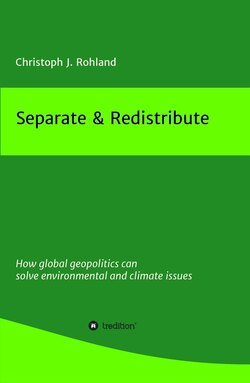Читать книгу Separate & Redistribute - Christoph J. Rohland - Страница 11
На сайте Литреса книга снята с продажи.
ОглавлениеThe climate solution
In order to get over the obstacle of each country performing its own situational reflections and national analyses, we first need an interpretive outline for all current international efforts. What have they already achieved and implemented? Which secular alliances need to be encouraged, and which need to be halted, and why?
If we truly want to build an international community, a climate government, then we first need to get all people from every single country around the world onboard and working towards a common goal. Recognising, collectively formulating and effectively implementing a common goal requires monumental thought and personal conscience. The resulting decision often brings with it a deep moral responsibility and obligation. It is not just up to the respective governments and major companies to shift the climate focus in such a way so as to enable a legitimate World Climate Council to sustainably implement its globally made decisions. Collective action is facilitated by everyone – all nations and states playing a part in this new institution.
The fact that we already showed willingness to work together worldwide and were able to take relevant measures within the space of just a few years was proven by the example of the ozone layer. In 2019, the hole above Antarctica was the smallest it had been since the 1980s. It would be wrong to attribute this to the success of global protective measures, but, thanks to the tightening of jointly enacted rules, we can be sure that the air in the stratosphere above the South Pole contains fewer and fewer of the manmade substances known to destroy our precious ozone, such as CFCs.
We have yet to establish a single, global authority that legally co-ordinates and governs the handling of water, air, sun and nature in a centralised manner. When it comes to using these natural supplies provided by our planet, however, we can go beyond local, individual interests and consider how, in addition to national/international alliances with all continents, we can create a worldwide set of climate regulations without interfering in the political world order.
What would happen if all the world’s federal governments were able to submit their country-specific climate and environmental concerns to a central international authority? What would it be like to have a World Climate Council with exclusive legal capacity in this sphere of expertise and law? How we treat our planet – no matter which continent, nation, state or region we call home – is defined not by politics or corporate profit, but by the issue of climate and the environment.
When it comes to protecting and perpetuating our world after potential climate collapse, it is absolutely essential for all nations and their people to think and act on a global level. Every nation on earth, no matter how big or small, is ultimately too small an individual decision-maker to take sole responsibility for our world. In geological matters and the resulting consequences for humanity, in this most critical of points, we need to join forces to collectively orientate ourselves and distribute our commons. Just as we identified the hole in the ozone layer, so we today need insight for tightened, jointly recognised rules within an international regulatory framework.
By establishing and recognising an international executive council, with a strong parliament, responsible for the whole world, we can address pressing issues raised by all national committees in relation to handling energy and nature, and solve these internationally.
